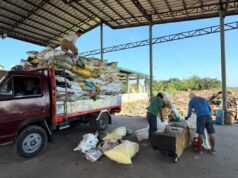
BALANGA CITY — Migratory birds seem to be like people who are on the go, industrious. This was the observation of participants in the media tour and birdwatching organized by the Wetland International Philippines in coordination with the Balanga City Wetland and Nature Park and Barangay Tortugas on Feb. 27.
The birds were ready before daybreak to leave their resting place among lush mangroves at the wetland park in Barangay Tortugas to search for food.
Wetland park tourism officer Alan Balbuena said the migratory birds follow a daily routine of leaving the mangroves before 6 a.m. and fly back between 5 p.m. and 6 p.m.
The birds seemed to be in a hurry before the sun shines in vacating the mangroves heading towards rice fields, dried fishponds in various parts of Bataan where they feast on worms, insects and small fish.
Karen Ochavo, environment officer of Regional Flyway Initiative, Asian Development Bank and vice president of the Wild Bird Club of the Philippines, said migratory birds start arriving in the Philippines by September to October.
“Darating sila dito kasi kapag tag-lamig sa Northern Hemisphere. Dito pumupunta para makakain sila, mag-survive sila habang winter doon sa breeding grounds nila ng ganoong panahon,” she said.
“Tapos pagdating ng bandang March-April so springtime na, babalik na ulit sila sa Northern Hemisphere. Breeding sila doon, tapos dito non-breeding pero nandito sila kumbaga parang bakasyon habang winter doon,” Ochabo added.
“Kasi masyadong malamig yung food sources nila wala na kapag ganoong panahon so dito mainit pa din kumbaga ito yung condition na pwede silang mamalagi dito. Seasonal kasi siya taon-taon ganoon ang pattern ng mga migratory birds,” she said.
Ochavo said the migratory birds travel through the East Asia-Australian flyway from Russia, Siberia, Alaska, part of America, Japan, Korea, China, Australia, and New Zealand. “Dahil sa sobrang layo, ang iba titigil sa Pilipinas, so depende sa species ng ibon.”
She said it is estimated that there are 50 million migratory waterbirds of over 250 different population or species of which 36 are threatened and 19 near-threatened.
Mila Ramirez of the provincial environment and natural resources office said that in the waterbird census of Jan. 27, 2024, there were 16,410 of 31 species in Balanga City compared to 16,078 in 2023.
Most of those counted were unidentified egrets. “Unidentified kasi nga yung pagko-converge nila saka during the time of census na mas maaga hindi pa nakikita kung talagang anong klaseng mga egrets itong nakita natin na ito kaya mas madami pa rin ang unidentified egrets and herons,” Ramirez said.
Tortugas barangay chairman Rolando Dizon observes that many migratory birds frequent their place but he would also like the local birds to be given attention which he said is already being done by Gov. Jose Enrique Garcia 3rd and Mayor Francis Garcia.
He said that birds, both local and migratory, are attracted to the wetland park because of its thick mangrove swamps that the number tripled during the onslaught of the Covid-19 pandemic.
“Noong may Covid 19, walang naglakad dito sa buhangin, walang naligo sa dagat kaya dumami ang tumubong mangrove. Nabulaga kami sa dami ng mangrove na mas maganda kaya lang natakpan ang view ng dagat. Nakabuti naman dahil dumami paitlugan ng mga alimango at isda,” Dizon said.
The barangay leader now understands that the wetland, the mudflats are like nutrients to the birds.




